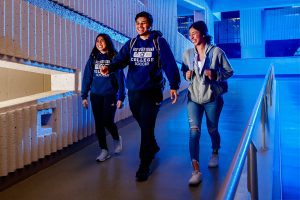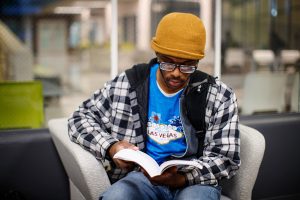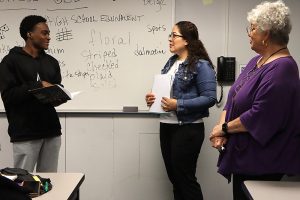The general education requirements for the Associate in Applied Science Degree are listed below. Students must fulfill the requirements of Group I,II, III, and IV or V. On the following pages you will find the specific course requirements for each program. The purpose of general education at SSC is not simply to prepare students for a life of work, but to prepare them for the work of their lives. Throughout the history of the West, the emphasis in education has been on the study of both Mind and Nature, and the goals of education have remained constant:
G1. The student will demonstrate critical thinking through written, oral or skill-based activities
G2. The student will argue with insight, intelligence, eloquence and responsibility.
G3. The student will express oneself with discipline and creativity.
G4. The student will demonstrate an understanding of discipline specific material and how it interrelates with other subjects.
G5. The student will recognize the existence of a multi-cultural society and demonstrate an appreciation of multiple perspectives.
G6. The student will evaluate the impact of science and technology on the individual, society and the natural world.
Technology
T1. Students will demonstrate the use of a variety of forms of technology as fundamental tools.
T2. Students will demonstrate the effective application of current computers and software to a particular field of study.
C2. Students will compose, develop and deliver effective, English, language-based oral presentations for a variety of purposes.
C3. Students will demonstrate an understanding of the various forms of rhetoric.
C4. Students will integrate library/research skills into various areas of study.ENG 101 — Composition and Rhetoric
SPE 108 — Oral Communication
And…
H1. Students will identify and analyze ideas, movements, civilizations and cultures.
H2. Students will critically assess and express ideas about cultural diversity and individual roles in society.Fine Arts
FA1. Students will apply aesthetic reasoning for the expression, analysis, and interpretation of art forms.
FA2. Students will express themselves by creating or performing works of verbal or non-verbal Art.ART 101 — Drawing I
ART 105 — History of Art, Ancient World
ART 106 — History of Art, Medieval & Renaissance
ART 107 — Art Appreciation
ART 109 — Ceramics
ART 110 — Metals and Jewelry
ART 111 — Two Dimensional Design
ART 112 — Three Dimensional Design
ART 113 — Color Theory and Practice
ART 130 — Computer Art I
ART 140 — Photography I Digital
ART 201 — Painting
ART 219 — Non Western Art
ART 221 — The History of Art in Architecture
DRM 151 — Theatre Appreciation
DRM 152 — Plays and Playwrights
ENG 103 — Introduction to American Literature I, 1607-Civil War
ENG 104 — Introduction to American Literature II, Civil War to Present
ENG 111 — Introduction to Literature I
ENG 122 — Creative Writing
ENG 123 — Ethnic Studies in African American Literature
ENG 124 — Introduction to Linguistics, Structure and Function of English Language
ENG 202 — Introduction to British Literature I
ENG 203 — Introduction to British Literature II
ENG 204 — Shakespeare
ENG 206 — World Literature
ENG 207 — World Literature II
ENG 208 — Introduction to Women’s Literature
HFA 108 — Intro to Film Appreciation
HFA 109 — Intro to Film History
HFA 158 — Drama Into Film
HFA 201 — General Humanities I
HFA 202 — General Humanities II
HFA 203 — Humanities of Eastern Asia
MUS 106 — Fundamentals of Music
MUS 116 — Music Theory I
MUS 115 — Introduction to Music Literature
MUS 123 — Music Appreciation
MUS 151-165 — Private Applied Music
MUS 169 — Class Instruction Piano I
MUS 170 — Class Instruction Piano II
MUS 173 — Class Instruction, Voice
MUS 174 — Class Instruction, Voice
MUS 187 — South Suburban College Voices
MUS 190 — South Suburban College Chorale
MUS 195 — Symphonic Band
MUS 197 — Jazz Lab (dance band workshop)
MUS 198 — Orchestra
MUS 220 — Introduction to Rock & Roll
MUS 221 — Introduction to Jazz
MUS 223 — Introduction to African American Music
PHL 101 — Introduction to Philosophy
PHL 102 — Ethics
PHL 103 — World Religions
PHL 105 — Logic
SPN 101 — Elementary Spanish I
SPN 102 — Elementary Spanish II
SPN 113 — Elementary Conversational Spanish
SPN 115 — Spanish for Health Care Providers I
SPN 203 — Intermediate Spanish I
SPN 204 — Intermediate Spanish II
SPN 205 — Spanish for the Spanish Speaking
SPN 213 — Intermediate Conversational Spanish
URB 141 — African-American Arts
And…
SB2. Students will use the principles of Social and Behavioral Science to analyze and interpret individual and world issues.ANT 101 — Anthropology
ECO 201 — Principles of Economics, Macro
ECO 202 — Principles of Economics, Micro
GEO 103 — Geography of the Developed World
GEO 104 — Geography of the Emerging World
HIS 101 — History of Modern Eastern Asian Civilization
HIS 109 — Europe to the 19th Century
HIS 110 — History of Modern Europe (19th and 20th Centuries)
HIS 151 — African American History
HIS 203 — Early American History
HIS 204 — Later American History
HIS 271 — History of Modern African Civilization
HSA 101 — Introduction to Human Services
PSC 101 — American National Government
PSC 102 — American Local and State Governments
PSC 108 — Contemporary Political Problems
PSC 210 — Comparative Foreign Governments
PSY 101 — Introduction to Psychology (Science of Human Behavior)
PSY 103 — Psychology of Personal Adjustment
PSY 204 — Social Psychology
PSY 205 — Theories of Personality
PSY 206 — Abnormal Psychology
PSY 211 — Human Growth and Development (Life-span)
PSY 212 — Adolescent Psychology
PSY 220 — Human Sexuality
SOC 101 — Introduction to Sociology
SOC 102 — Social Problems
SOC 205 — Marriage and the Family
SOC 206 — Juvenile Delinquency
SOC 225 — Ethnic and Racial Relations
URB 101 — Introduction to Urban Studies
And…
M2. Students will integrate mathematical relationships with other fields of study.MTH 100 — Intermediate Algebra
MTH 103 — Fundamentals of Mathematics
MTH 106 — Technical Mathematics I, Algebra and Trigonometry
MTH 111 — Technical Mathematics II, Analytic Geometry and Introduction to Calculus
MTH 115 — General Education Mathematics
MTH 126 — Fundamentals of Statistics
MTH 145 — Math Concepts & Structures I
MTH 146 — Math Concepts & Structures II
MTH 161 — Finite Mathematics
MTH 165 — College Algebra
MTH 167 — Plane Trigonometry
MTH 169 — Precalculus
MTH 170 — Discrete Mathematics
MTH 180 — Calculus for Business and Social Science
MTH 190 — Calculus and Analytic Geometry I
MTH 211 — Statistics
MTH 200 — Introduction to Linear Algebra
MTH 203 — Calculus and Analytic Geometry II
MTH 204 — Calculus and Analytic Geometry III
MTH 205 — Differential Equations
BUS 105 — Business Mathematics
Or…
PS2. Students will apply fundamental scientific conceptual frameworks for understanding and evaluating natural phenomena and their causes and effects.AST 101 — Introduction to Astronomy
BIO 101 — Concepts of Biology
BIO 102 — Introductory Biology
BIO 103 — Environmental Biology
BIO 104 — Microbes and Society
BIO 105 — General Biology I
BIO 115 — Human Body Structure
BIO 185 — Human Anatomy and Physiology I
BIO 152 — Man and His Environment
CHM 101 — Chemistry and Society
CHM 111 — Introductory Chemistry I
CHM 113 — General Chemistry I
GLG 101 — Physical Geology
PHS 101 — Physical Science
PHY 101 — Mechanics, Heat and Sound
PHY 115 — Topics in Applied Physics
PHY 210 — University Physics I
All students must demonstrate minimum math competency equivalent to MTH 095 in those programs in which mathematics is not a specific requirement. Keyboarding is an expected competency in many career programs and can be shown by taking OAT 100 or having had high school course(s) or demonstrating proficiency through ECEP.




